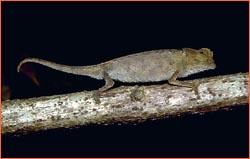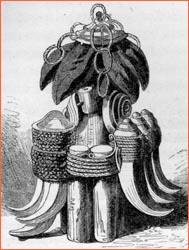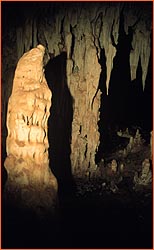 |

|

|
by Peter Tyson To the Westerner, many beliefs of the Malagasy, the people of Madagascar, boggle the mind. For starters, the Malagasy believe their ancestors live on in the afterworld, communicating with the living through spirit possession, taboos, and other means. Taboos are particularly potent: Never eat while lying down, your parents will be choked; never point at a tomb, your fingers will fall off, and so on. During exuberant celebrations known as famadihana ("bone-turnings"), certain tribes regularly disinter and rewrap their dead kin in new burial shrouds, essentially to keep them content in the afterlife so they will bestow blessings on their survivors. The Malagasy hold to the inexorable forces of destiny, so much so that in former times babies born on unlucky days were put to death by, among other horrific practices, placing them alive in anthills. Arguably most disconcerting to foreigners is mpakafo, literally "heart-stealer," a widespread fear in rural Madagascar that white people have come to the island to kill Malagasy in order to feast on their vital organs, which they somehow need to survive (see A Forest Full of Frights). Perhaps most outlandish for the modernized Westerner, however, is the pervasive belief in various and sundry beasts that tread the diverse landscapes of this 1,000-mile-long island. Some of these creatures are benign, many nefarious. Some are human, many decidedly not. Most sound mythical to the outsider, but some are possibly all too real.
To the Malagasy, the ancestors are protective spirits if you treat them well, but angatra, or ghosts of the dead, are something else entirely. The Betsimisaraka, one of the island's 18 officially recognized tribes, have a particular dread of the angatra, which are said to haunt the graves of the individuals to whom they once belonged and can cause living persons who offend them to fall ill or suffer misfortunes. Loud talking and laughing is said to be particularly objectionable, and no Betsimisaraka would tread near a grave at night or even build a house too near a gravesite for fear of angering the angatra. Some of these ghosts of the dead are known as kinoly. Kinoly look like real people, though they have red eyes, long fingernails, and a nasty habit of eviscerating their fellow Malagasy. One story holds that a Malagasy who once met a kinoly asked it, "How is it your eyes are so red?" and the kinoly said, "God passed by them." The Malagasy then asked, "How is it your nails are so long?" The ghost replied "That I may tear out your liver" and immediately did so. In the 1885 issue of The Antananarivo Annual and Madagascar Magazine, a periodical published in the Malagasy capital in the 19th century, the English missionary G. Herbert Smith recalled the time a ghost attacked one of his boatmen: [A]bout midnight we were aroused by terrible groans and exclamations, and on our going to him, we found him sitting up trembling, and he declared to us that he had not been asleep, but that soon after he lay down something came and grasped him by the throat, preventing him for some time from calling out. He assured us that there was a ghost there, and that he must come and share our house, which he did. Another missionary, as reported in the 1892 Annual, once made the mistake of showing a visiting chief and his entourage a skull he kept for study:
I shall not soon forget the look of horror that took possession of his friend, and positively believe the sight of the skull had a reflex action on his pneumogastric nerve, so that he had to make a speedy exit, followed by the whole company, who had observed the object of terror by that time and its effect upon their leader. Spirits of a long-vanished people known as the Vazimba are also said to haunt the landscape. The Malagasy claim the Vazimba lived on Madagascar long before they first scraped ashore in their oceangoing outrigger canoes about 2,000 years ago. When I visited a cave system known as Anjohibe ("Big Cave") in the western part of the island, for instance, local Sakalava tribesmen warned that Vazimba lived in the caverns. Continue: Wild Men and Other Monsters The Expedition | Surviving The Wilds | Explore Madagascar Dispatches | Classroom Resources | E-Mail | Resources Site Map | The Wilds of Madagascar Home Editor's Picks | Previous Sites | Join Us/E-mail | TV/Web Schedule About NOVA | Teachers | Site Map | Shop | Jobs | Search | To print PBS Online | NOVA Online | WGBH © | Updated November 2000 |
 To the Westerner, many Malagasy beliefs may be hard to understand, such as the notion that the tiny stump-tailed chameleon is a forest genie that can bring bad luck.
To the Westerner, many Malagasy beliefs may be hard to understand, such as the notion that the tiny stump-tailed chameleon is a forest genie that can bring bad luck. An idol worshipped by Malagasy in the 19th century
An idol worshipped by Malagasy in the 19th century Malagasy living around Anjohibe Cave believe that spirits of the Vazimba reside within the caverns.
Malagasy living around Anjohibe Cave believe that spirits of the Vazimba reside within the caverns.